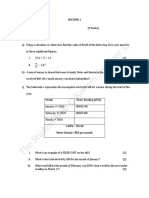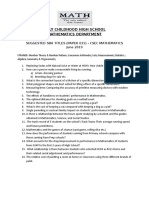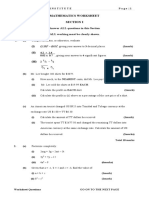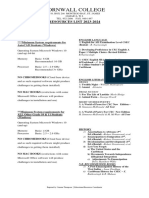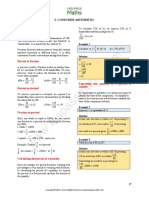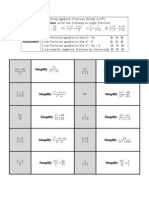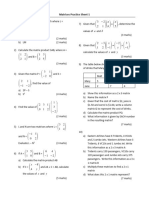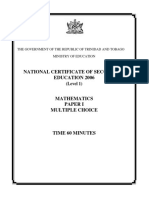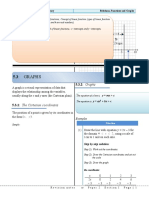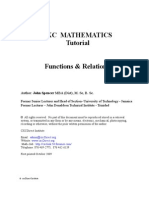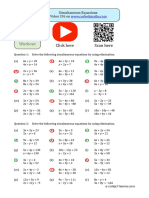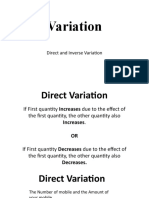CSEC MATH CLASS
NOTES
======================================================
Operations in Arithmetic
The basic arithmetic operations are
Addition
Subtraction
Multiplication
Division
Exponentiation (raise to the power of…)
The Basic Arithmetic Properties
Commutative Property
The commutative property describes equations in which the order of the numbers
involved does not affect the result. Addition and multiplication are commutative
operations:
2+3 = 3+2 = 5
5⋅2 = 2⋅5 = 10
Subtraction and division, however, are not commutative.
Associative Property
The associative property describes equations in which the grouping of the numbers
involved does not affect the result. As with the commutative property, addition and
multiplication are associative operations:
(2+3) + 6 = 2 + (3+6) =11
(4⋅1) ⋅ 2 = 4⋅ (1⋅2) = 8
Once again, subtraction and division are not associative.
Distributive Property
The distributive property can be used when the sum of two quantities is then multiplied
by a third quantity.
(2+4) ⋅3 = 2⋅3 + 4⋅3=18
Negative Numbers
Arithmetic operations can be performed on negative numbers according to specific rules.
1|Page
� POSITIVE AND NEGATIVE INTEGERS
Adding Integers
Rule: If the signs are the same, add and keep the same sign.
(+) + (+) = add the numbers and the answer is positive
(‐) + (‐) = add the numbers and the answer is negative
Rule: If the signs are different, subtract the numbers and use the sign of the larger number.
(+) + (‐) = subtract the numbers and take the sign of the bigger number
(‐) + (+) = subtract the numbers and take the sign of the bigger number
Subtracting Integers
(+) – (+) = (+) + (‐) take the sign of the bigger number
(‐) – (‐) = (‐) + (+) take the sign of the bigger number
(+) – (‐) = (+) + (+) answer is positive
(‐) – (+) = (‐) + (‐) answer is negative
Multiplying and Dividing Integers
Rule: If the signs are the same, multiply or divide and the answer is always positive.
(+) x (+) = + (+) divided by (+) = +
(‐) x (‐) = + (‐) divided by (‐) = +
Rule: If the signs are different, multiply or divide and the answer is always negative.
(+) x (‐) = ‐ (+) divided by (‐) = ‐
(‐) x (+) = ‐ (‐) divided by (+) = ‐
2|Page
� A. Rules for Adding Positive and Negative Numbers
To add two positive numbers, add and keep the positive sign
Example: (+6) + (+7) = 13
To add two negative numbers, add and keep the negative sign
Example: (-13) + (-24) = -37
To add numbers with different signs, find the difference between the two numbers
(subtract) and give the answer the sign of the larger number
Example #1: (+17) + (-6) = 11
Example #2: (-32) + (+18) = -14
** When signs are different, subtract the smaller number and keep the sign of the bigger
number.
B. Rules for Subtracting Positive and Negative Numbers
To subtract signed numbers (either positive or negative), change the subtraction sign to
addition and change the sign of the number that follows, then revert back to the addition
rules
Example #1: (+8) - (+5) = (+8) + (-5) = 3
Example #2: (+7) - (-4) = (+7) + (+4) = 11
Example #3: (-12) - (+6) = (-12) + (-6) = -18
Example #4: (-23) - (-16) = (-23) + (+16) = -7
C. Rules for Multiplying and Dividing Positive and Negative Numbers
With both multiplication and division, when the signs are the same, the answer will be
positive
Example #1: (+5) × (+7) = 35
Example #2: (-5) × (-7) = 35
Example #3: (+10) ÷ (+2) = 5
Example #4: (-10) ÷ (-2) = 5
When the signs are different in a multiplication or division problem, the answer will be
negative
Example #1: (+8) × (-7) = -56
Example #2: (-12) × (+4) = -48
Example #3: (+9) ÷ (-3) = -3
Example #4: (-14) ÷ (+2) = -7
3|Page
� Order of Operations and Positive and Negative Numbers
When a number of mathematical operations are to be performed in a problem, you must
follow a specific order for solving the problem.
Step 1 – Do anything that is inside parentheses
Step 2 - Solve anything that contains an exponent (a power – 52 – the 2 is the exponent
and it means the base number is to be multiplied by itself that number of times, so
52 = 5 ×5 = 25)
Step 3 – Solve any multiplication or division within the problem, moving from left to
right
Step 4 – Solve any addition or subtraction within the problem, moving from left to right
We will use the acronym PEMDAS for order of operations
Example #1: -2(12 – 8) + -33 + 4 • -6
-2(4) + -33 + 4 • -6
-2(4) + -27 + 4 • -6
-8 + -27 + -24
-35 + -24
-59
Example #2: -3 + 4(2 - 6)2 ÷ -2
-3 + 4(-4)2 ÷ -2
-3 + 4(16) ÷ -2
-3 + 64 ÷ -2
-3 + -32
-35
4|Page
� POSITIVE AND NEGATIVE INTEGERS
PRACTICE SHEET
A. Solve the following problems.
1. -2 + (+3) = 11. -3(-4) = 21. 45 - (-27) =
2. -5 + (+4) = 12. 24 ÷ (-6) = 22. 19(-4) =
3. 5 - (-3) = 13. 5(-18) = 23. -42 ÷ (-6) =
4. -7 - (-3) = 14. -8 ÷ (-4) = 24. -21 + -19 =
5. -14 - 6 = 15. 17(-4) = 25. 32 ÷ (-4) =
6. 6 + (-8) = 16. 81 ÷ (-9) = 26. 14 - (-7) + (-2) =
7. 12 + (+7) = 17. -21 ÷ (-7) = 27. -8 • -4 ÷ -2 =
8. -8 + (-1) = 18. -7(9) = 28. -24 ÷ 4 + -17 =
9. -9 - (+6) = 19. 8(7) = 29. 7 - (-3) + (-2) - 4 =
10. 11 + (-2) = 20. 56 ÷ (-14) = 30. 12 + (-7) - (-28) =
5|Page
�B. Use order of operations to solve the following problems.
1. 18 - (-12 - 3) = 7. -19 + (7 + 4)3 =
2. 18 + (-7) • (32 – 6) = 8. -19 - (-3) + -2(8 + -4) =
3. 20 + -4(32 - 6) = 9. -3 + 2(-6 ÷ 3)2
4. 3 • (-4) + (52 + -4 • 2) - (-9.82) = 10. 23 + (-16) ÷ 42 • 5 - (-3) =
5. -6(12 - 15) + 23 = 11. 4(-6) + 8 - (-2) =
15 – 7 + 2
6. -50 ÷ (-10) + (5 - 3)4 = 12. 1.4(4.7 – 4.9) - 12.8 ÷ (-0.2) =
-4.5 • (-0.53) + (-1)
6|Page
� FRACTIONS
What is a Fraction?
Fractions: A fraction represents a part of a whole and consists of an integer numerator
and a non-zero integer denominator. (A ratio of two numbers).
Parts of a Fraction
Numerator: The number that sits above the fraction bar and represents the part of the
whole number.
Denominator: The number that sits below the fraction bar and represents the whole
number.
Reciprocal: A fraction that is turned upside down so that the numerator and denominator
have switched places.
FACTORS & MULTIPLES
Factors and multiples are different things.
But they both involve multiplication:
Factors are what we can multiply to get the number
Multiples are what we get after multiplying the number by an integer (not a fraction).
Example: the positive factors, and some multiples, of 6:
Factors:
1 × 6 = 6, so 1 and 6 are factors of 6
2 × 3 = 6, so 2 and 3 are factors of 6
Multiples:
0 × 6 = 0, so 0 is a multiple of 6
1 × 6 = 6, so 6 is a multiple of 6
2 × 6 = 12, so 12 is a multiple of 6
7|Page
� Definition of decimal system
1: a number system that uses a notation in which each number is expressed in base 10
by using one of the first nine integers or 0 in each place and letting each place value be
a power of 10
2: a system of measurement or currency in which the basic units increase by powers of
10
The Place Value Chart
Adding and Subtracting Decimals
To add decimals, follow these steps:
Write down the numbers, one under the other, with the decimal points lined up
Put in zeros so the numbers have the same length (see below for why that is OK)
Then add, using column addition, remembering to put the decimal point in the
answer
Example: Add 1.452 to 1.3
Line up the decimal points: 1.452
+ 1.3
"Pad" with zeros: 1.452
+ 1.300
Add: 1.452
+ 1.300
2.752
8|Page
�To subtract, follow the same method: line up the decimal points, then subtract.
Example: What is 7.368 − 1.15 ?
7.368
Line up the decimal points:
− 1.15
"Pad" with zeros: 7.368
− 1.150
Subtract: 7.368
− 1.150
6.218
How to Multiply Decimals
Just follow these steps:
Multiply normally, ignoring the decimal points.
Then put the decimal point in the answer - it will have as many decimal places as the
two original numbers combined.
In other words, just count up how many numbers are after the decimal point in both numbers
you are multiplying, then the answer should have that many numbers after its decimal point.
Example: Multiply 0.03 by 1.1
start with: 0.03 × 1.1
multiply without decimal points: 3 × 11 = 33
0.03 has 2 decimal places,
and 1.1 has 1 decimal place,
so the answer has 3 decimal places: 0.033
9|Page
� Dividing Decimals
The trick is to get rid of the decimal point from the number we are dividing by.
How? We can "shift the decimal point" out of the way by multiplying by 10, as many
times as we need to.
But we must do the same thing to both numbers in the division.
Example: 15 divided by 0.2
Let us multiply the 0.2 by 10, which shifts the decimal point out of the way:
0.2 × 10 = 2
But we must also do it to the 15:
15 × 10 = 150
So 15 ÷ 0.2 has become 150 ÷ 2 (they are both 10 times larger):
150 ÷ 2 = 75
And so the answer is:
15 ÷ 0.2 = 75
10 | P a g e
� Rounding Off Numbers
What is "Rounding" ?
Rounding means making a number simpler but keeping its value close to what it was.
The result is less accurate, but easier to use.
How to Round Numbers
0,1,2,3 and 4 are on team "down"
5,6,7,8 and 9 are on team "up"
Example: 73 rounded to the nearest ten is 70, because 73 is closer to 70 than to 80. But
76 goes up to 80.
Steps:
Decide which is the last digit to keep
Leave it the same if the next digit is less than 5 (this is called rounding down)
But increase it by 1 if the next digit is 5 or more (this is called rounding up)
Example: Round 74 to the nearest 10
We want to keep the "7" (it is in the 10s position)
The next digit is "4" which is less than 5, so no change is needed to "7"
Answer: 70
(74 gets "rounded down")
Example: Round 86 to the nearest 10
We want to keep the "8"
The next digit is "6" which is 5 or more, so increase the "8" by 1 to "9"
Answer: 90
(86 gets "rounded up")
So: when the first digit removed is 5 or more, increase the last digit remaining by 1.
11 | P a g e
� Rounding Decimals
First work out which number will be left when we finish.
Rounding to tenths means to leave one number after the decimal point.
Rounding to hundredths means to leave two numbers after the decimal point.
etc.
3.1416 rounded to hundredths is 3.14
as the next digit (1) is less than 5
3.1416 rounded to thousandths is 3.142
as the next digit (6) is more than 5
1.2735 rounded to tenths is 1.3
as the next digit (7) is 5 or more
To round to "so many decimal places" count that many digits from the decimal point:
1.2735 rounded to 3 decimal places is 1.274
as the next digit (5) is 5 or more
Rounding Whole Numbers
We may want to round to tens, hundreds, etc, In this case we replace the removed digits
with zero.
134.9 rounded to tens is 130
as the next digit (4) is less than 5
12,690 rounded to thousands is 13,000
as the next digit (6) is 5 or more
15.239 rounded to ones is 15
as the next digit (2) is less than 5
12 | P a g e
� Rounding to Significant Digits
To round to "so many" significant digits, count digits from left to right, and then round
off from there.
Here are the basic rules for significant digits:
1) All nonzero digits are significant.
2) All zeroes between significant digits are significant.
3) All zeroes which are both to the right of the decimal point and to the right of all non-
zero significant digits are themselves significant.
Examples
1.239 rounded to 3 significant digits is 1.24
as the next digit (9) is 5 or more
134.9 rounded to 1 significant digit is 100
as the next digit (3) is less than 5
When there are leading zeros (such as 0.006), don't count them because they are only
there to show how small the number is:
0.0165 rounded to 2 significant digits is 0.017
as the next digit (5) is 5 or more
Round 742,396 to four, three, and two significant digits:
1. 742,400 (four significant digits)
2. 742,000 (three significant digits)
3. 740,000 (two significant digits)
Round 0.07284 to four, three, and two significant digits:
1. 0.07284 (four sig-digs)
2. 0.0728 (three sig-digs)
3. 0.073 (two sig-digs)
Round 231.45 to four, three, and two significant digits:
1. 231.5 (four sig-digs)
2. 231 (three sig-digs)
3. 230 (two sig-digs)
13 | P a g e
